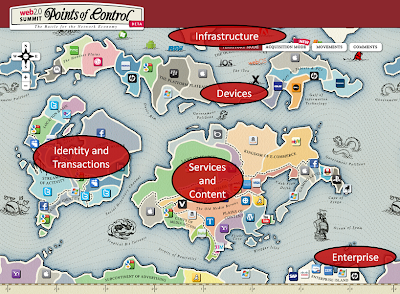So by the very title, the organisers believe that the initial period of rapid expansion of the consumer internet is drawing to a close. If true, the organisers believe that existing dominant players are shifting their policies from the the rush-everywhere, hasty land grab to retreat to their strategic power bases to pit themselves against each other in a market that is now maturing.
Admittedly, this Points of Control map and the introductory video (which is very illuminating) can be written off as pre-conference rabble-baiting, I disagree on several points:
Enterprise Participation has only just started
To date, Web 2.0 has been consumer driven. John and Tim rightly point out that big corporates have only just started to engage with the Web 2.0 concept and their audience. This is SO true - there is a huge potential here, which has only just begun: use of social software to interact with consumers over a wider of devices and technologies.
I for one predicted in 2002 that the consumer internet and the enterprise internet would together mutually drive adoption. In actuality, the consumer internet proved to be much more vibrant and exciting than the enterprise internet. Now, I believe, it is the turn of the enterprise.
Also, I believe that exciting services from enterprises will drive another growth phase in internet.
Viewpoint is US-centric
In terms of users, the internet is opening up to a vast pool of users who have been denied it to date: BRIC represent a user base to equal the existing user base. The services that they use will not be in the English language. Nor will they access internet services in a desktop manner: mobile (smart) phones, tablets, powerful netbooks.
Summary of the Map
Clearly, this maps was intended to controversial and the authors intended it to generate feedback. Here's my interpretation of the map (with my overlay):
(click for a larger image)
The map can be summarised in tiers:
- Infrastructure: XaaS - 'X as a Service' where X is Platform,
- Devices: these are the platforms that users access service
- Services & Content: obvious I hope, but the line between services, devices and infrastructure will continue to blur. (The diagram needs isthmuses or bridges or low-lying marshy areas???
- Identity & Transactions: Historical memory of users: their attributes, preferences, transactions, behaviour. Currently, this area is welded into Services. I believe that this will fragment into a separate user-centric cluster of identity services (with bridges and integration points everywhere)
- Enterprises: these could be classed as Services, but this 'land mass' is so substantial and has so much potential that IS worth breaking this out as a separate territory.
Update: Speaker Slides and Videos

No comments:
Post a Comment